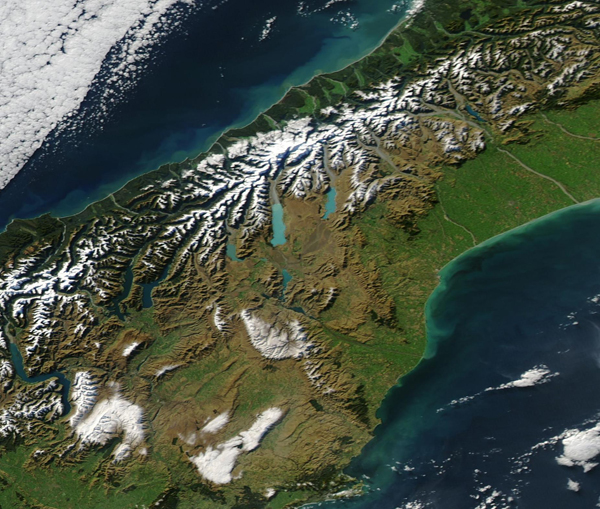Images
May 19, 2019 - Aoraki Mount Cook National Park and the Southern Alps
Tweet
Aoraki Mount Cook National Park has been described as a rugged land of ice and rock, with skyscraping peaks, glaciers and permanent snow fields, all set under a star-studded sky. The park, which sits in the Southern Alps, encompasses 23 peaks over 3,000 meters (9,842.52 feet), including New Zealand’s highest Mountain, Aoraki/Mount Cook. The park’s largest glacier, the Tasman Glacier, extends about 27 km (16.8 mi) long and is at least 600 meters (1,968.5 feet) thick. As the massive glacier slowly carves a deep valley, it also forms a stunning, milky-blue terminal lake. Lake Pukaki, as Tasman Glacier’s lake is known, can be seen as the largest brightly colored lake in the tall mountains of the park.
The rugged Southern Alps extend some 650 kilometers (400 miles) along the western side of New Zealand's South Island. The mountains are often obscured by clouds, which is probably why the Maoris called New Zealand "Aotearoa", the long white cloud. The higher peaks are snow-covered all year round. Westerly winds bring clouds that drop over 500 centimeters (195 inches) of rain annually on luxuriant rain forest along the west coast. The drier eastern seaboard is home to the majority of the island's population.
On May 17, 2019, the Moderate Resolution Imaging Spectroradiometer (MODIS) on board NASA’s Aqua satellite acquired a true-color image of New Zealand’s South Island which highlighted Aoraki Mount Cook National Park and the Southern Alps.
Image Facts
Satellite:
Aqua
Date Acquired: 5/17/2019
Resolutions:
1km (220 KB), 500m (565.8 KB), 250m (1.1 MB)
Bands Used: 1,4,3
Image Credit:
MODIS Land Rapid Response Team, NASA GSFC
Tweet
Aoraki Mount Cook National Park has been described as a rugged land of ice and rock, with skyscraping peaks, glaciers and permanent snow fields, all set under a star-studded sky. The park, which sits in the Southern Alps, encompasses 23 peaks over 3,000 meters (9,842.52 feet), including New Zealand’s highest Mountain, Aoraki/Mount Cook. The park’s largest glacier, the Tasman Glacier, extends about 27 km (16.8 mi) long and is at least 600 meters (1,968.5 feet) thick. As the massive glacier slowly carves a deep valley, it also forms a stunning, milky-blue terminal lake. Lake Pukaki, as Tasman Glacier’s lake is known, can be seen as the largest brightly colored lake in the tall mountains of the park.
The rugged Southern Alps extend some 650 kilometers (400 miles) along the western side of New Zealand's South Island. The mountains are often obscured by clouds, which is probably why the Maoris called New Zealand "Aotearoa", the long white cloud. The higher peaks are snow-covered all year round. Westerly winds bring clouds that drop over 500 centimeters (195 inches) of rain annually on luxuriant rain forest along the west coast. The drier eastern seaboard is home to the majority of the island's population.
On May 17, 2019, the Moderate Resolution Imaging Spectroradiometer (MODIS) on board NASA’s Aqua satellite acquired a true-color image of New Zealand’s South Island which highlighted Aoraki Mount Cook National Park and the Southern Alps.
Image Facts
Satellite:
Aqua
Date Acquired: 5/17/2019
Resolutions:
1km (220 KB), 500m (565.8 KB), 250m (1.1 MB)
Bands Used: 1,4,3
Image Credit:
MODIS Land Rapid Response Team, NASA GSFC




